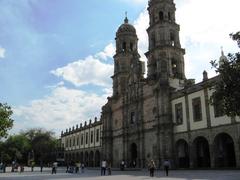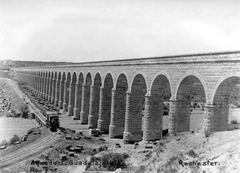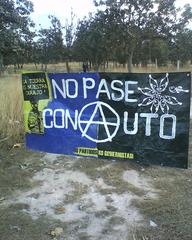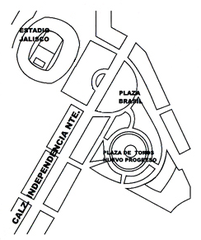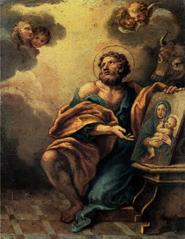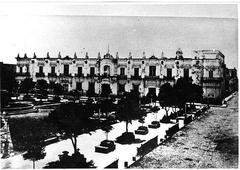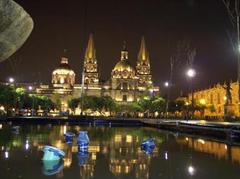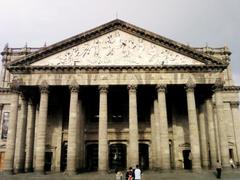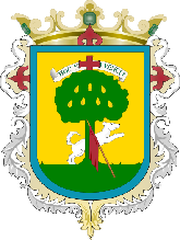Visiting Hours, Tickets, and Historical Sites at Plaza Guadalajara, Guadalajara, Mexico
Date: 18/07/2024
Introduction
Plaza Guadalajara, nestled in the heart of Guadalajara, Mexico, stands as a vibrant testament to the city’s rich history, culture, and architectural grandeur. Established shortly after the founding of the city in 1542, Plaza Guadalajara has evolved from a colonial gathering place to a modern cultural hub, reflecting the dynamic changes that have shaped Guadalajara over the centuries. Visitors to this iconic plaza can immerse themselves in a blend of historical narratives, architectural marvels, and lively cultural events. The surrounding landmarks, such as the Guadalajara Cathedral with its stunning neo-Gothic towers and the Palacio de Gobierno adorned with murals by José Clemente Orozco, further enrich the visitor experience. Whether one is drawn by the historical significance, the architectural beauty, or the vibrant cultural activities, Plaza Guadalajara offers something for everyone. This comprehensive guide will delve into the plaza’s historical evolution, provide essential visitor information, and highlight nearby attractions that make a visit to Plaza Guadalajara an unforgettable experience (Guadalajara Cathedral, Palacio de Gobierno, International Mariachi Festival).
Table of Contents
- Introduction
- Early Beginnings
- Colonial Era
- 19th Century Transformations
- 20th Century Developments
- Modern Era
- Architectural Significance
- Cultural Impact
- Preservation Efforts
- Visitor Experience
- Nearby Attractions
- Guadalajara Cathedral
- Rotonda de los Jaliscienses Ilustres
- Palacio de Gobierno
- Teatro Degollado
- Plaza de Armas
- Instituto Cultural Cabañas
- Mercado San Juan de Dios
- Plaza Tapatía
- Hospicio Cabañas
- Templo Expiatorio del Santísimo Sacramento
- Museo Regional de Guadalajara
- Plaza de los Mariachis
- Parque Agua Azul
- FAQ
- Conclusion
Early Beginnings
Plaza Guadalajara, located in the heart of Guadalajara, Mexico, has a rich history that dates back to the colonial era. The city of Guadalajara was founded on February 14, 1542, by Cristóbal de Oñate, under the orders of Nuño de Guzmán. The plaza itself was established shortly thereafter as a central gathering place for the burgeoning community. It was designed following the traditional Spanish colonial urban planning model, which emphasized a central square surrounded by important civic and religious buildings.
Colonial Era
During the colonial period, Plaza Guadalajara served as the focal point for social, political, and economic activities. The plaza was surrounded by significant structures, including the Guadalajara Cathedral, which began construction in 1561 and was completed in 1618. The cathedral’s presence underscored the plaza’s importance as a religious center. The plaza also hosted markets, public gatherings, and official ceremonies, making it a vital part of daily life in colonial Guadalajara.
19th Century Transformations
The 19th century brought significant changes to Plaza Guadalajara. Following Mexico’s independence from Spain in 1821, the plaza continued to be a central hub for the city. In the mid-1800s, the plaza underwent renovations to modernize its appearance and functionality. These changes included the addition of new landscaping, the installation of fountains, and the construction of new public buildings around the square. The plaza’s role as a civic center was further solidified during this period, as it became a site for political rallies and public speeches.
20th Century Developments
The 20th century saw further transformations in Plaza Guadalajara. In the early 1900s, the plaza was redesigned to accommodate the growing population and the increasing importance of Guadalajara as a major Mexican city. The introduction of electric streetcars in the 1920s made the plaza more accessible, enhancing its role as a transportation hub. During this time, the plaza also became a popular location for cultural events, including concerts, festivals, and public art displays.
Modern Era
In recent decades, Plaza Guadalajara has continued to evolve while maintaining its historical significance. The plaza has been the focus of several urban renewal projects aimed at preserving its historical character while enhancing its functionality for modern use. These projects have included the restoration of historical buildings, the improvement of public spaces, and the introduction of new amenities for visitors. Today, Plaza Guadalajara remains a vibrant and dynamic part of the city, attracting both locals and tourists alike.
Architectural Significance
The architecture surrounding Plaza Guadalajara is a testament to the city’s rich history. The Guadalajara Cathedral, with its stunning neo-Gothic towers, is a prominent feature of the plaza. Other notable buildings include the Palacio de Gobierno, which houses the state government offices and features impressive murals by the renowned artist José Clemente Orozco. These architectural landmarks not only add to the aesthetic appeal of the plaza but also serve as important cultural and historical symbols.
Cultural Impact
Plaza Guadalajara has played a significant role in shaping the cultural identity of the city. The plaza has been a venue for numerous cultural events, including the annual Fiestas de Octubre, which celebrates the city’s founding with music, dance, and traditional Mexican cuisine. The plaza also hosts various art exhibitions, performances, and public gatherings, making it a central part of Guadalajara’s cultural life.
Preservation Efforts
Efforts to preserve Plaza Guadalajara’s historical and cultural significance have been ongoing. The plaza is part of the Historic Center of Guadalajara, which has been designated as a UNESCO World Heritage Site. This designation has helped to ensure that the plaza and its surrounding buildings are protected and maintained for future generations. Preservation efforts have included the restoration of historical facades, the conservation of public art, and the implementation of measures to protect the plaza’s architectural integrity.
Visitor Experience
Today, visitors to Plaza Guadalajara can experience a blend of history, culture, and modern amenities. The plaza offers a variety of attractions, including guided tours of the Guadalajara Cathedral, visits to the Palacio de Gobierno, and opportunities to explore local markets and shops. The plaza’s central location makes it an ideal starting point for exploring the rest of the city, with many of Guadalajara’s top attractions within walking distance.
Visiting Hours and Tickets
Plaza Guadalajara is open to the public 24 hours a day, although individual attractions such as the Guadalajara Cathedral and the Palacio de Gobierno have specific visiting hours. It is recommended to check their official websites for the most up-to-date information on visiting hours and ticket prices. Generally, the cathedral is open from 8 AM to 8 PM, and the Palacio de Gobierno from 9 AM to 6 PM. Entry to the plaza itself is free, but some attractions may require a ticket.
Travel Tips
- Best Time to Visit - The best time to visit Plaza Guadalajara is during the cooler months from November to February. If you enjoy festivals, consider visiting in October for the Fiestas de Octubre.
- Getting There - The plaza is easily accessible by public transportation, including buses and the light rail system. If you’re driving, there are several parking options nearby.
- Local Cuisine - Don’t miss out on trying local delicacies from the surrounding markets and street vendors. Tacos, tortas ahogadas, and birria are must-tries.
- Safety Tips - While the plaza is generally safe, it’s always a good idea to stay vigilant, especially during crowded events.
Nearby Attractions
Guadalajara Cathedral
One of the most prominent attractions around Plaza Guadalajara is the Guadalajara Cathedral, also known as the Cathedral of the Assumption of Our Lady. This stunning structure, with its neo-Gothic towers and baroque interior, dates back to the 16th century. The cathedral is not only a place of worship but also a repository of art and history. Visitors can admire the beautiful stained glass windows, intricate altars, and numerous religious artifacts. The cathedral is open to the public daily, and admission is free. (Guadalajara Cathedral)
Visitor Information
- Visiting Hours: Daily, 7:00 AM - 8:00 PM
- Tickets: Free admission
- Travel Tips: Visit early in the morning to avoid crowds and enjoy a peaceful experience.
Rotonda de los Jaliscienses Ilustres
Adjacent to the cathedral is the Rotonda de los Jaliscienses Ilustres, a monument dedicated to the illustrious people of Jalisco. This circular structure, surrounded by statues of notable figures from the state, serves as a tribute to those who have made significant contributions to the arts, sciences, and politics. The rotunda is a peaceful place to reflect on the region’s rich history and achievements. (Rotonda de los Jaliscienses Ilustres)
Visitor Information
- Visiting Hours: Open 24 hours
- Tickets: Free admission
- Travel Tips: Ideal for a quiet stroll and reflection.
Palacio de Gobierno
The Palacio de Gobierno, or Government Palace, is another must-see attraction near Plaza Guadalajara. This historic building, constructed in the 18th century, houses the offices of the state government. Visitors can explore the palace’s beautiful courtyards and admire the impressive murals by José Clemente Orozco, which depict scenes from Mexican history. The palace is open to the public, and guided tours are available. (Palacio de Gobierno)
Visitor Information
- Visiting Hours: Monday to Friday, 9:00 AM - 5:00 PM
- Tickets: Free admission
- Guided Tours: Available upon request
Teatro Degollado
A short walk from Plaza Guadalajara is the Teatro Degollado, one of the city’s most important cultural venues. This neoclassical theater, inaugurated in 1866, hosts a variety of performances, including opera, ballet, and concerts. The theater’s interior is equally impressive, with its ornate decorations and stunning frescoes. Visitors can attend a performance or take a guided tour to learn more about the theater’s history and architecture. (Teatro Degollado)
Visitor Information
- Visiting Hours: Varies by performance schedule
- Tickets: Prices vary by event
- Travel Tips: Check the theater’s schedule in advance and book tickets early for popular performances.
Plaza de Armas
Plaza de Armas, located just a few steps from Plaza Guadalajara, is another popular gathering spot in the city. This picturesque square is surrounded by historic buildings, including the Palacio de Gobierno and the Cathedral. The plaza features a beautiful bandstand, where live music performances are often held, and numerous benches where visitors can relax and enjoy the surroundings. (Plaza de Armas)
Visitor Information
- Visiting Hours: Open 24 hours
- Tickets: Free admission
Instituto Cultural Cabañas
A bit further from Plaza Guadalajara, but still within walking distance, is the Instituto Cultural Cabañas. This UNESCO World Heritage site, originally built as an orphanage in the early 19th century, is now a cultural center and museum. The institute is home to an impressive collection of modern and contemporary art, as well as the famous murals by José Clemente Orozco. The building’s architecture, with its neoclassical design and expansive courtyards, is also worth exploring. (Instituto Cultural Cabañas)
Visitor Information
- Visiting Hours: Tuesday to Sunday, 10:00 AM - 6:00 PM
- Tickets: General admission - $70 MXN
- Travel Tips: Plan to spend at least two hours to fully explore the institute.
Mercado San Juan de Dios
For a more immersive cultural experience, visitors can head to Mercado San Juan de Dios, one of the largest indoor markets in Latin America. Located a short distance from Plaza Guadalajara, this bustling market offers a wide variety of goods, including fresh produce, traditional crafts, and local delicacies. It’s an excellent place to sample authentic Mexican cuisine and purchase souvenirs. (Mercado San Juan de Dios)
Visitor Information
- Visiting Hours: Daily, 7:00 AM - 8:00 PM
- Tickets: Free admission
- Travel Tips: Bring cash for purchases and be prepared to haggle for the best prices.
Plaza Tapatía
Plaza Tapatía, an expansive pedestrian plaza, connects Plaza Guadalajara with the Instituto Cultural Cabañas. This lively area is filled with fountains, sculptures, and street vendors, making it a great place to stroll and soak in the local atmosphere. The plaza also hosts various cultural events and festivals throughout the year, providing visitors with a taste of Guadalajara’s vibrant culture. (Plaza Tapatía)
Visitor Information
- Visiting Hours: Open 24 hours
- Tickets: Free admission
Hospicio Cabañas
Another significant attraction near Plaza Guadalajara is the Hospicio Cabañas, a historic building that now serves as a cultural center and museum. This UNESCO World Heritage site is renowned for its stunning architecture and the impressive murals by José Clemente Orozco that adorn its walls. The Hospicio Cabañas offers a glimpse into the city’s rich cultural heritage and is a must-visit for art and history enthusiasts. (Hospicio Cabañas)
Visitor Information
- Visiting Hours: Tuesday to Sunday, 10:00 AM - 6:00 PM
- Tickets: General admission - $70 MXN
- Travel Tips: Combine your visit with a tour of the Instituto Cultural Cabañas to make the most of your day.
Templo Expiatorio del Santísimo Sacramento
A short distance from Plaza Guadalajara is the Templo Expiatorio del Santísimo Sacramento, a beautiful neo-Gothic church known for its intricate design and stunning stained glass windows. The church’s clock tower, with its carillon of 25 bells, is a highlight, and visitors can often hear the bells playing traditional Mexican melodies. The Templo Expiatorio is a serene place to visit and offers a peaceful respite from the bustling city. (Templo Expiatorio del Santísimo Sacramento)
Visitor Information
- Visiting Hours: Daily, 7:00 AM - 8:00 PM
- Tickets: Free admission
- Travel Tips: Attend a Sunday service to experience the church’s vibrant community.
Museo Regional de Guadalajara
For those interested in learning more about the region’s history, the Museo Regional de Guadalajara is an excellent destination. Located near Plaza Guadalajara, this museum houses a vast collection of artifacts, including pre-Columbian relics, colonial-era objects, and works of art. The museum’s exhibits provide a comprehensive overview of Jalisco’s history and culture, making it a valuable educational experience for visitors. (Museo Regional de Guadalajara)
Visitor Information
- Visiting Hours: Tuesday to Sunday, 9:00 AM - 5:00 PM
- Tickets: General admission - $55 MXN
- Travel Tips: Allocate at least an hour to explore the museum’s extensive collection.
Plaza de los Mariachis
Music lovers should not miss Plaza de los Mariachis, a lively square dedicated to the traditional Mexican music genre. Located a short distance from Plaza Guadalajara, this plaza is filled with mariachi bands ready to serenade visitors with their vibrant tunes. The plaza is also home to several restaurants and bars, where visitors can enjoy a meal or a drink while listening to live music. (Plaza de los Mariachis)
Visitor Information
- Visiting Hours: Open 24 hours
- Tickets: Free admission
- Travel Tips: Visit in the evening for the best musical performances.
Parque Agua Azul
For a break from the urban environment, visitors can head to Parque Agua Azul, a large park located a short drive from Plaza Guadalajara. This green oasis features beautiful gardens, walking paths, and a butterfly house. The park is a great place to relax and enjoy nature, and it also hosts various cultural events and exhibitions throughout the year. (Parque Agua Azul)
Visitor Information
- Visiting Hours: Daily, 6:00 AM - 6:00 PM
- Tickets: Free admission
- Travel Tips: Bring a picnic and enjoy a day outdoors with family or friends.
FAQ
Q - What are the best times to visit Plaza Guadalajara?
A - Early mornings and late afternoons are ideal to avoid crowds and enjoy a pleasant atmosphere.
Q - Are guided tours available for these attractions?
A - Yes, many of the attractions offer guided tours. It’s best to check their official websites or contact them directly for more information.
Q - Can I take photographs at these sites?
A - Most attractions allow photography, but it’s always a good idea to check for any specific restrictions, especially inside museums and churches.
Q - What is the best way to get around Plaza Guadalajara?
A - Walking is the best way to explore Plaza Guadalajara and its surrounding attractions, as many sites are within close proximity.
Conclusion
Plaza Guadalajara is not just a public square; it is a microcosm of Guadalajara’s rich history, cultural vibrancy, and architectural splendor. From its early beginnings in the colonial era to its modern-day role as a cultural and social hub, the plaza encapsulates the essence of Guadalajara’s evolution. Visitors can explore a myriad of attractions, from the historic Guadalajara Cathedral and the Palacio de Gobierno to the vibrant Mercado San Juan de Dios and the serene Parque Agua Azul. The plaza’s accessibility, coupled with its diverse array of nearby attractions, makes it an ideal destination for both locals and tourists. Whether you are delving into the historical significance of the plaza, enjoying cultural performances, or simply soaking in the lively atmosphere, Plaza Guadalajara offers a unique and enriching experience. Plan your visit today to explore the heart of Guadalajara and discover the many facets of this remarkable city (Guadalajara Tourism).
